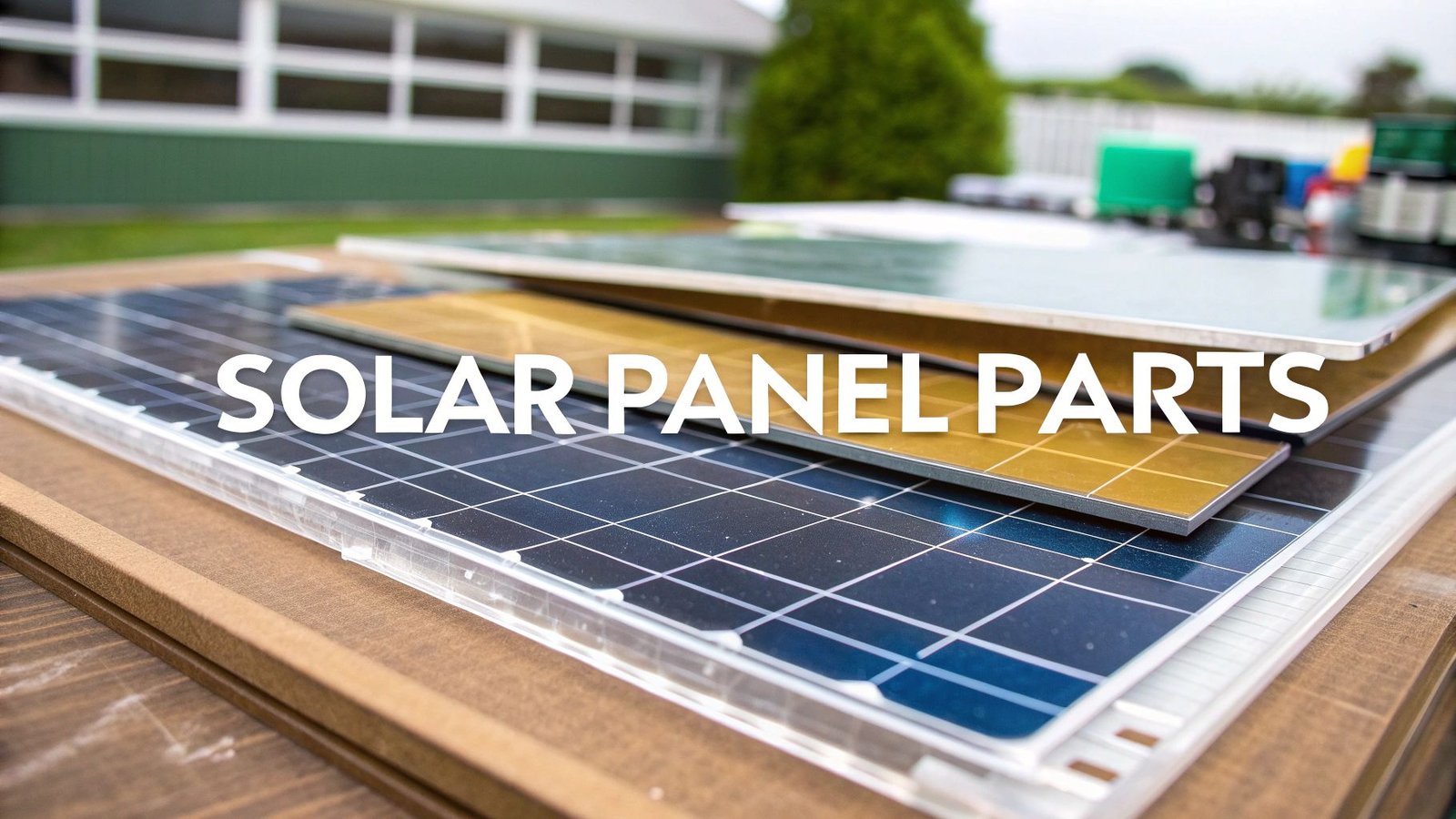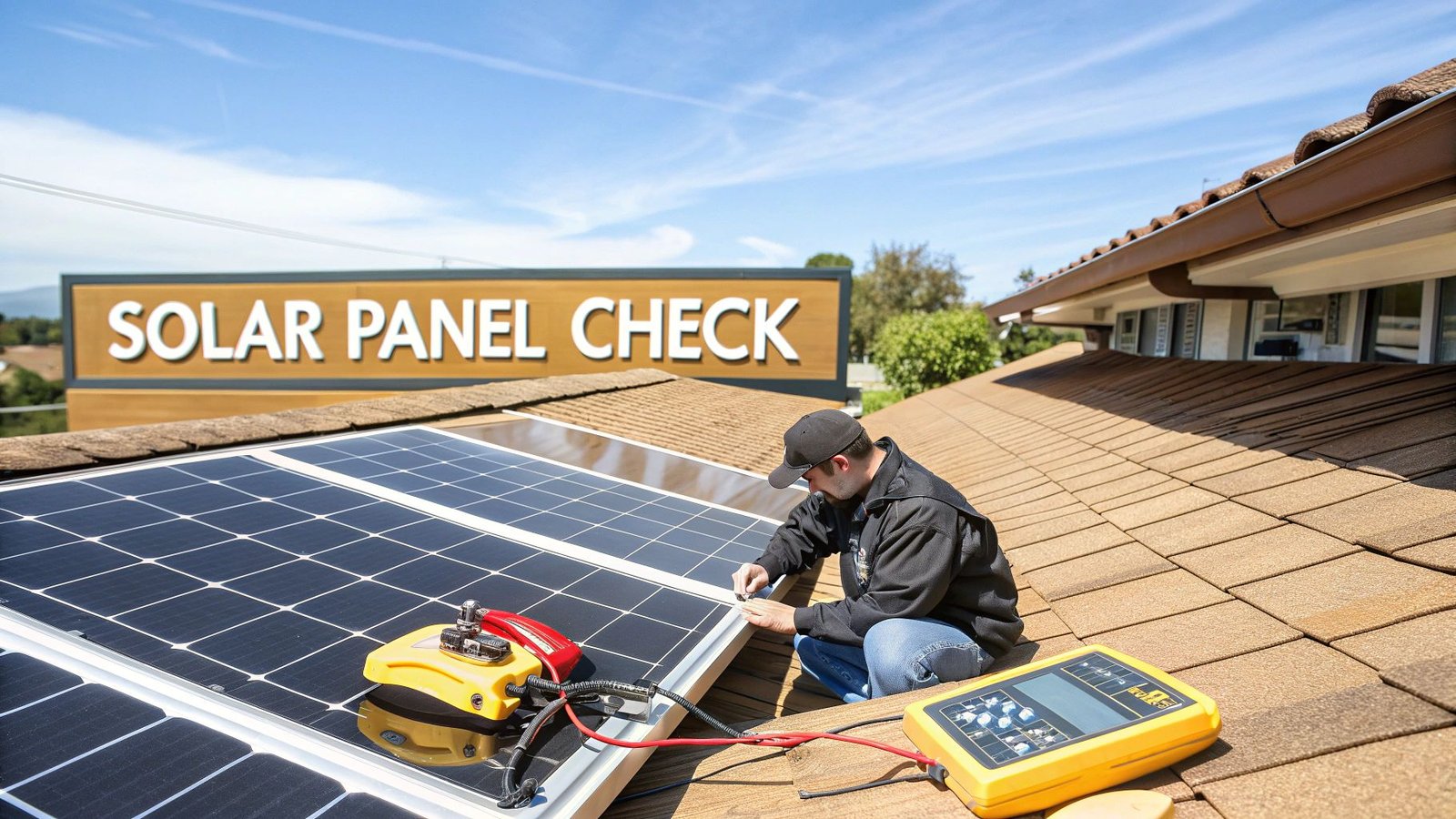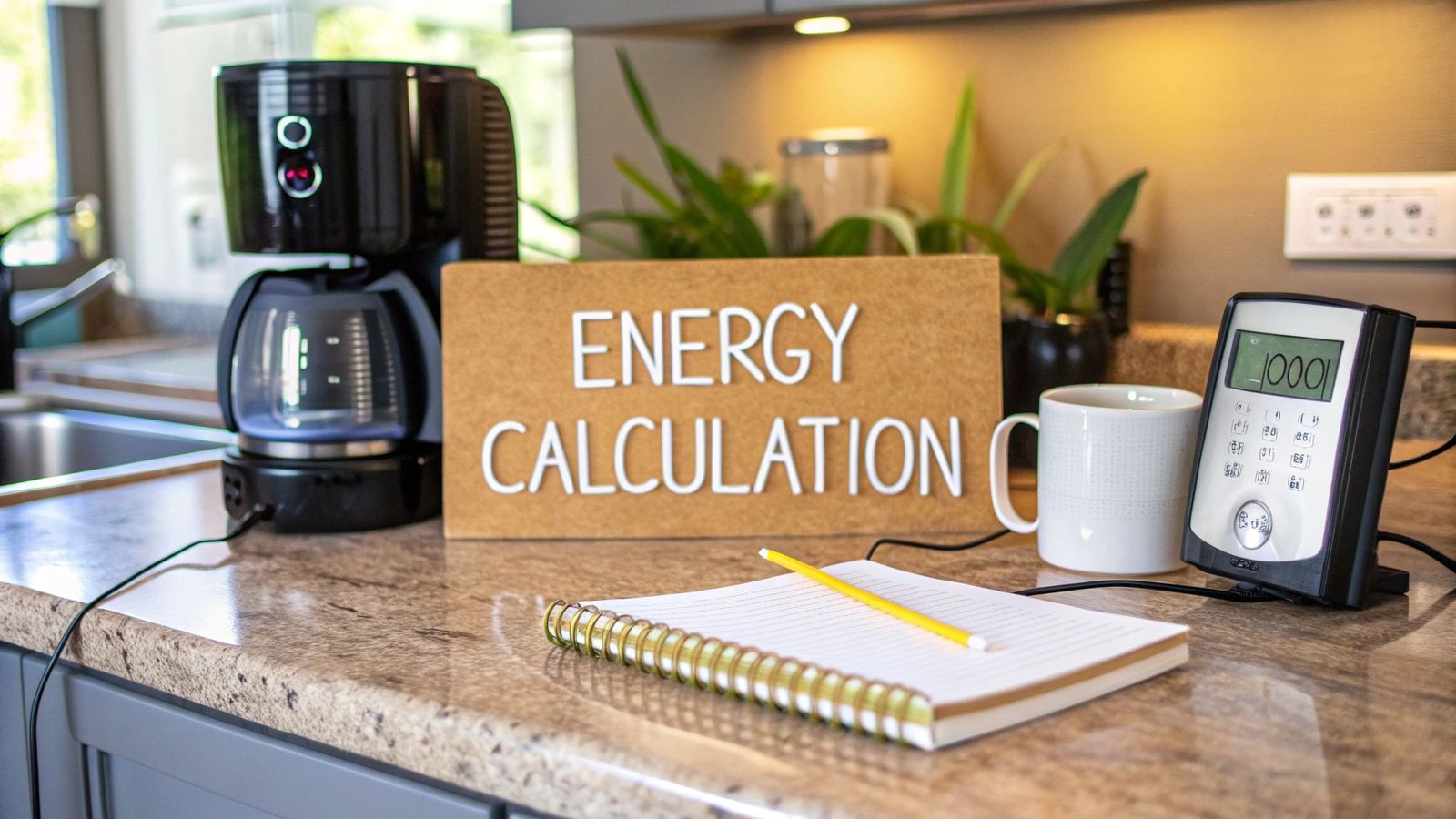From the outside, a solar panel looks like a simple sheet of glass in a metal frame. But that sleek exterior hides a sophisticated, multi-layered system where every single part has a critical job to do. Think of it as a high-tech sandwich, with each layer working together to catch sunlight and turn it into clean electricity for your home.
The key components of a solar panel are the photovoltaic (PV) cells, a tough glass casing, a sturdy aluminum frame, and a junction box on the back.
Deconstructing a Solar Panel
A solar panel is a masterclass in precision engineering. Every component is chosen for one reason: to help convert photons from the sun into a steady stream of electrons. This process depends on a clever combination of materials—some to generate the power, others to protect the sensitive electronics, and the rest to give the panel the structural strength to last for decades.
Getting to know these building blocks is the best first step you can take toward making a smart investment. The quality of each part has a direct impact on the panel's efficiency, how well it stands up to the elements, and how much power it will produce over its 25 to 30-year lifespan. When you're shopping for a solar system, what's inside the panel is every bit as important as the price.
The Main Component Groups
The image below gives you a great visual breakdown of a standard solar panel's anatomy.
As you can see, every piece fits into one of three main categories: the power-generating cells, the protective layers that shield them from harm, or the electrical parts that manage and direct the flow of energy. It’s this teamwork between components that ensures both top-tier performance and long-term reliability.
To give you a quick overview, here's a simple table breaking down what each part does.
Quick Guide to Solar Panel Components and Functions
This table provides an at-a-glance overview of the primary components inside a standard solar panel and the role each one plays in generating power and ensuring long-term performance.
| Component | Primary Material | Main Function |
|---|---|---|
| Photovoltaic (PV) Cells | Silicon (Monocrystalline or Polycrystalline) | The "engine" of the panel; converts sunlight directly into DC electricity. |
| Glass Sheet | Tempered Glass (with Anti-Reflective Coating) | Protects the fragile PV cells from weather, impacts, and debris while allowing maximum sunlight to pass through. |
| Encapsulant Layers | Ethylene Vinyl Acetate (EVA) | Bonds the components together, provides cushioning, and protects cells from moisture and dirt. |
| Backsheet | Polymer Composite | Acts as a moisture barrier and provides electrical insulation for the back of the panel. |
| Frame | Anodized Aluminum | Provides structural support, protects the edges, and allows for secure mounting. |
| Junction Box | Plastic Enclosure with Diodes | Houses the wiring and bypass diodes; directs the flow of electricity out of the panel. |
This interconnected design is what makes modern solar technology so robust.
A solar panel isn’t just a single thing; it’s a carefully assembled system. The silicon cells are the engine, the glass and backsheet are the armor, and the junction box is the command center that directs the flow of power.
Understanding how these parts affect performance is crucial when you start looking at your options. Our guide on how to choose solar panels dives deeper into how component quality should influence your decision.
Now, let's take a closer look at each of these components, starting with the absolute heart of the panel: the photovoltaic cells.
Silicon Cells: The Powerhouse of Every Panel
At the very heart of any solar panel, you'll find its engine: the photovoltaic (PV) cell. This is where the real magic happens. Think of each cell as a miniature power plant, working tirelessly to turn sunlight directly into electricity through what's called the photovoltaic effect. When photons from the sun hit the cell, they knock electrons loose, creating a flow of direct current (DC) electricity.
These cells are almost always made from silicon, a fantastic and abundant semiconductor. In fact, silicon-based cells are the undisputed champions of the solar world, accounting for over 80% of the world's installed solar capacity and dominating with a massive 90% market share. It's the bedrock technology of modern solar energy. You can dig into more data on silicon cell technology to see just how widespread it is.
<div style="background-color: #f9f9f9; border: 1px solid #ddd; padding: 20px; text-align: center;">
<h4 style="margin-top: 0; font-family: sans-serif;">Global Solar PV Market Share by Technology</h4>
<div style="display: flex; justify-content: center; align-items: flex-end; height: 200px; width: 100%;">
<div style="width: 40%; background-color: #007bff; color: white; display: flex; flex-direction: column; justify-content: flex-end; align-items: center; padding: 5px;">
<span style="font-weight: bold;">95%</span>
</div>
<div style="width: 5%; background-color: #6c757d; color: white; display: flex; flex-direction: column; justify-content: flex-end; align-items: center; padding: 5px;">
<span style="font-weight: bold;">5%</span>
</div>
</div>
<div style="display: flex; justify-content: center; align-items: flex-start; width: 100%; margin-top: 10px; font-family: sans-serif; font-size: 14px;">
<div style="width: 40%; text-align: center;">Silicon-Based Cells</div>
<div style="width: 5%; text-align: center;">Other</div>
</div>
</div>
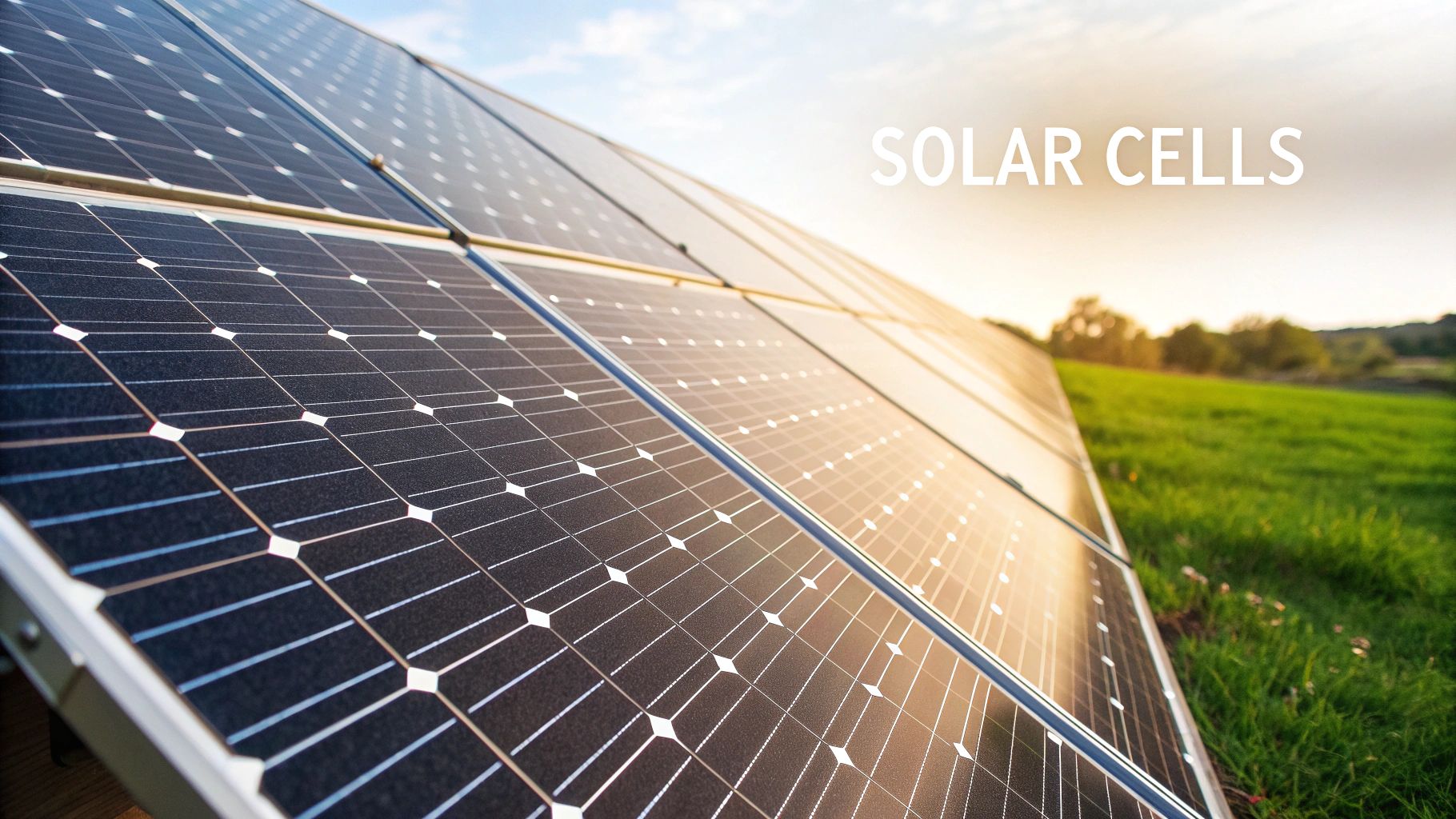
Monocrystalline vs. Polycrystalline Cells
While nearly all panels use silicon, the way that silicon is processed creates two very different types of cells. They have their own distinct looks, performance specs, and price tags, and knowing the difference is key to picking the right panel for your home or project.
The two main players you'll come across are monocrystalline and polycrystalline.
- Monocrystalline Cells (Mono): These are the high-performers. They're sliced from a single, pure silicon crystal, which gives them that sleek, uniform black look and often a clipped, octagonal shape. Because the crystal structure is so pure, electrons can move around more freely, which means higher efficiency.
- Polycrystalline Cells (Poly): These are made by melting down multiple silicon fragments and pouring the molten silicon into a square mold. This process is cheaper but creates grain boundaries within the cell that act as tiny roadblocks for electrons. This gives them their classic blue, marbled look and results in slightly lower efficiency.
Think of it like water flowing through a pipe. A monocrystalline cell is like a perfectly smooth, straight pipe—water (or electricity) flows with maximum speed. A polycrystalline cell is more like a pipe with a few twists and turns; the water still gets through, but it faces a bit more resistance along the way.
How Cell Type Affects Real-World Performance
The choice between mono and poly isn't just about aesthetics; it has a real impact on your system's output, cost, and even how it looks on your roof. This is where you have to weigh what matters most to you.
Let's break down the key differences side-by-side.
| Feature | Monocrystalline (Mono) | Polycrystalline (Poly) |
|---|---|---|
| Efficiency | Higher (15% to over 24%) | Lower (10% to 18%) |
| Appearance | Uniform black, octagonal cells | Blue, marbled, square cells |
| Cost | More expensive to produce | Less expensive to produce |
| Space Needed | Less roof space for the same power | More roof space for the same power |
| Heat Tolerance | Performs slightly better in high heat | Performance can dip more in extreme heat |
The trade-off here is pretty clear. Monocrystalline panels are the perfect solution if you have limited roof space or simply want to squeeze every last watt out of your system. Their superior efficiency means you get more power from a smaller area.
On the other hand, polycrystalline panels are a fantastic, budget-friendly choice, especially for larger installations where space isn't an issue. While each panel produces a little less power, their lower price point can make a bigger system more affordable, opening the door for more people to go solar.
The Protective Layers That Ensure Durability
While silicon cells are the powerhouses of a solar panel, they are incredibly delicate. On its own, a bare solar cell wouldn't survive a single day out in the elements. That's why every panel is encased in a multi-layered shield, meticulously engineered to handle decades of rain, hail, snow, and punishing sunlight.
These protective layers are just as vital as the cells themselves. They are the reason panels can come with the 25-year performance warranties that are now standard in the industry. Without them, a panel’s lifespan would be cut drastically short.

Tempered Glass: The Frontline Defense
The very top layer of any solar panel is a sheet of high-transmission tempered glass, usually about 3-4 mm thick. Its most obvious job is to be a tough, transparent barrier, defending the panel against physical impacts from things like hail or wind-blown debris.
But this isn't just any glass. It’s also treated with an anti-reflective (AR) coating. This microscopic layer is a game-changer; it reduces surface glare and helps funnel more sunlight down to the silicon cells instead of letting it bounce off. It’s a small detail that can boost a panel's total energy output by a few percentage points.
EVA Encapsulant: The Critical Cushion
Tucked between the glass and the solar cells is a crucial material called Ethylene Vinyl Acetate (EVA). During manufacturing, two thin films of this polymer are laid down—one on top of the cells and one underneath. The whole stack is then heated in a lamination machine, which melts the EVA and forms a perfectly sealed, weatherproof bond that locks everything in place.
The EVA serves two absolutely critical functions:
- Cushioning: It acts as a shock absorber, protecting the brittle silicon cells from vibrations and the physical stress that comes from expanding and contracting with temperature swings.
- Moisture Barrier: It creates an airtight seal that stops water, humidity, and dirt from getting inside and corroding the sensitive electrical connections.
Think of the EVA encapsulant as the clear, protective resin used to preserve a delicate fossil. It surrounds the valuable cells, shielding them from moisture and stress while remaining optically clear so sunlight can pass through unobstructed.
The Backsheet: The Final Protective Barrier
The very last layer in this protective sandwich is the backsheet. This is a tough, multi-layered polymer sheet that makes up the back surface of the panel.
Its job is to be the final line of defense. The backsheet provides essential electrical insulation, which is a critical safety feature that prevents any current from leaking out the back of the panel. It also doubles as the ultimate moisture barrier, making sure the internal components stay completely dry. The quality of this backsheet is a huge factor in preventing long-term degradation and guaranteeing the panel's durability over its entire life.
2. The Frame and Junction Box: Skeleton and Brains
Beyond the layers that actually generate power, a solar panel needs two more things to be a truly robust piece of equipment: a skeleton and a brain. The aluminum frame provides the structural backbone, giving the panel its strength, while the junction box on the back acts as the electrical command center, making sure the power gets where it needs to go.
The aluminum frame is the unsung hero of a panel's longevity. Think of it as the chassis of a car—its job is to hold everything together and protect the delicate inner workings from the stress of the outside world. It gives the panel the rigidity it needs to handle heavy winds, snow loads, or even the bumps and twists of installation.
This structural support is what lets us securely bolt these things to a roof. Most frames are built from anodized aluminum, a great material for the job because it’s strong, lightweight, and incredibly resistant to rust and corrosion, even after decades of rain and sun.
The Junction Box: The Panel's Nerve Center
If the frame is the skeleton, the junction box is the nerve center. Tucked away on the back of the panel, this small, weatherproof plastic box is where all the electricity produced by the solar cells is gathered and routed out through cables. It might not look like much, but it plays a massive role in the panel's performance and safety.
Inside this box, you'll find a critical component: bypass diodes. These are essentially one-way electrical valves, but their real magic comes into play when a panel is partially shaded. Even a single leaf or bird dropping can block a cell, and without bypass diodes, that tiny obstruction could act like a roadblock and choke the output of the entire panel.
You can think of a bypass diode like a clever detour on a busy highway. If one lane (a solar cell) gets completely blocked by an accident (shade), the diode opens up an alternate route. This allows the rest of the traffic (electricity) to keep moving instead of getting stuck in a massive jam.
This bit of smart engineering means a small patch of shade won't bring your energy production to a screeching halt, helping you get more consistent power throughout the day.
How These Parts Guarantee Reliability
Together, the frame and junction box are the guardians of a panel's long-term reliability. A sturdy frame prevents physical stress from creating tiny, power-sapping microcracks in the silicon cells. At the same time, a properly sealed junction box keeps moisture and dirt from corroding the all-important electrical connections.
Here’s a quick breakdown of how they protect the panel:
| Component | Primary Function | How It Boosts Longevity |
|---|---|---|
| Aluminum Frame | Provides structural rigidity and secure mounting points. | Protects the fragile inner layers from physical damage caused by wind, snow, and general handling. |
| Junction Box | Houses wiring and bypass diodes for electrical management. | Ensures safe electrical connections and minimizes power loss from partial shading, maximizing lifetime energy output. |
Ultimately, these two components transform a collection of high-tech layers into a durable, intelligent, and reliable power source ready to withstand the elements for 25 years or more.
A Quick Look Back: How Solar Panel Parts Evolved
To really get a feel for the incredible technology packed into today's solar panels, it helps to understand where they came from. The journey from a scientific curiosity to a global energy powerhouse is a story of one breakthrough building on another. Trust me, the early versions were nothing like the sleek panels we see on rooftops now.
The story starts way back in 1883. An inventor named Charles Fritts created the first modern solar cell using selenium wafers and a whisper-thin layer of gold. It worked, but it only managed to convert about 1 to 2 percent of sunlight into electricity. A huge achievement for the time, but a drop in the bucket compared to the 15 to 20 percent efficiency that's standard for today's panels. The real game-changer arrived in 1954 when Bell Laboratories unveiled the first practical silicon solar cell, hitting an efficiency of around 6 percent. That was the moment that set the stage for modern solar power. If you're a history buff, you can dig into the early patent milestones over at Finnegan's historical overview.
From Lab Experiments to Rooftop Power Plants
That jump from single-digit efficiency to the workhorses we have today wasn't a fluke. It took decades of relentless innovation in material science, improving not just the solar cells themselves, but every single piece of the puzzle around them. Engineers and scientists were tackling the big three problems holding solar back: sky-high costs, questionable durability, and sluggish performance.
This chart really puts the progress into perspective, showing how efficiency shot up as new technologies came online.
The Little Things That Made a Big Difference
It wasn't just one big invention that pushed solar forward. A handful of key improvements to the supporting components completely changed what was possible, making solar energy both reliable and affordable.
- Tougher Encapsulants: The discovery of materials like Ethylene Vinyl Acetate (EVA) was a massive win. This polymer layer acts like a protective cushion, sealing the delicate silicon cells from moisture and impact. It’s a huge reason why panels went from lasting just a few years to having warranties of 25 years or more.
- Anti-Reflective Coatings: A simple but brilliant idea. Early panels lost a surprising amount of energy because sunlight would just bounce off the shiny glass. Adding a special anti-reflective coating allowed much more light to pass through to the cells, giving the panel's output a noticeable boost.
The history of solar is a fantastic example of persistent problem-solving. Every single part, from the glass cover to the aluminum frame, has been continuously tweaked and improved with one goal in mind: make solar power more efficient, more durable, and cheap enough for everyone.
How Component Quality Affects Your System's Output
When you piece together all the individual components of a solar panel, a simple truth emerges: the quality of each part is directly tied to your system’s performance, its durability, and ultimately, your financial return. Choosing a panel isn't just about picking a brand; it's about understanding the materials that make it tick. Even seemingly small upgrades in component quality can lead to major gains over the panel's typical 25-year lifespan.
Take the anti-reflective coating on the glass, for instance. A premium coating might only boost light absorption by a few percentage points. That sounds small, but it adds up to more kilowatt-hours generated every single day, year after year. The same goes for the backsheet—a high-quality one is your best defense against moisture and degradation, ensuring your panel keeps working hard for decades instead of giving up early.
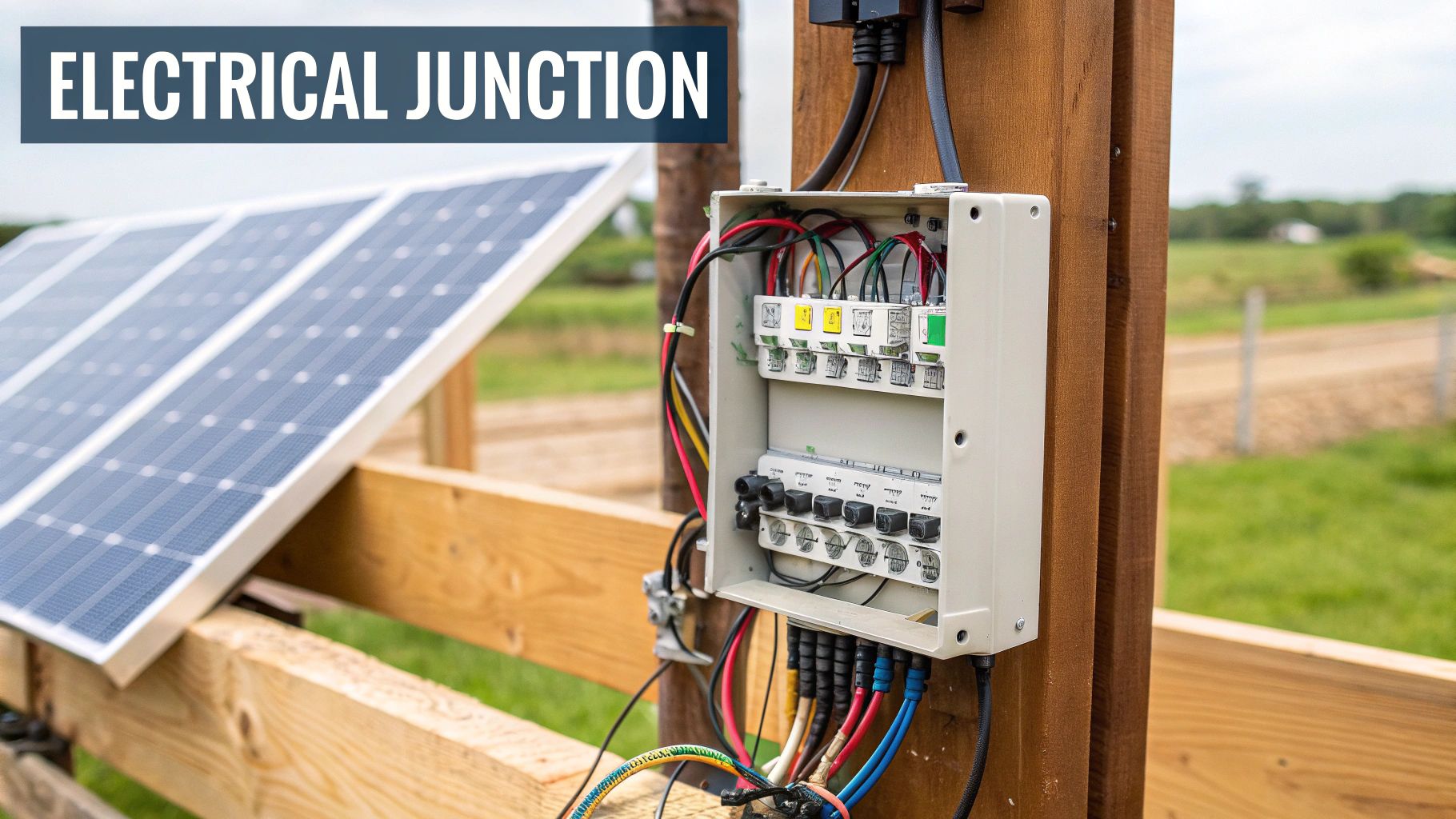
Comparing Standard vs. Premium Components
The real difference between a standard panel and a premium one often boils down to these subtle material choices. One manufacturer might use a basic, single-layer backsheet, while another invests in a multi-layered, UV-resistant polymer that offers far better protection. This single choice can affect everything from day-to-day power output to whether the panel survives a hailstorm ten years from now.
Think of it like buying tires for your car. Sure, budget tires will get you down the road. But premium tires give you better grip, last longer, and improve your car's overall performance. The initial investment is a bit higher, but the long-term value and safety are worth it.
This insight helps you ask smarter questions when you're looking at different panel options. In the end, the power your system generates is only as strong as its weakest link.
Impact of Component Quality on Panel Performance
The table below breaks down just how much of a difference these material choices make. It’s a clear look at how small upgrades in manufacturing can lead to significant improvements in real-world performance and longevity.
| Component | Standard Quality Impact | Premium Quality Impact |
|---|---|---|
| Solar Cells | Higher degradation rate, leading to a noticeable drop in power output within the first 10-15 years. | Lower degradation, ensuring more consistent power production over the panel's full 25+ year lifespan. |
| Glass | Basic anti-reflective coating that wears off, reducing light absorption over time. More susceptible to micro-cracks from impacts. | Advanced, durable anti-reflective coating for sustained high light absorption. Tempered for superior impact resistance. |
| Backsheet | Prone to yellowing, delamination, and moisture penetration, which can cause cell failure and rapid power loss. | Multi-layered, UV-resistant materials that prevent moisture ingress and protect cells for decades, ensuring system reliability. |
| EVA Encapsulant | Can yellow and become brittle with UV exposure (browning), reducing the light reaching the cells and causing power loss. | High-quality, non-browning EVA that remains clear and flexible, maximizing light transmission and protecting cells long-term. |
| Frame | Thinner aluminum that can bend under heavy snow loads or high winds, potentially compromising the panel's structural integrity. | Robust, anodized aluminum frame designed to withstand extreme weather conditions, protecting all internal components. |
It's clear that investing in quality from the start pays dividends for years to come. While the panel itself is the heart of the system, creating DC power, the quality of every other piece of equipment is just as critical. For a deeper look at another essential component, our guide explains what solar inverters are and the vital role they play in your system.
A Few Common Questions About Solar Panel Parts
Once you start looking into the details of solar panels, a few questions almost always pop up. Getting these answers sorted out is a great way to feel more confident about the technology you're bringing into your home.
Why Are Some Panels Blue and Others Black?
You've probably noticed this yourself—some panels have a deep, uniform black color, while others have a blue, almost marbled look. This all comes down to the type of silicon used inside.
The blueish panels are called polycrystalline. They're made by melting down multiple silicon fragments and reforming them into a wafer. That process creates the signature multi-crystal look.
Black panels are monocrystalline, and they're sliced from a single, pure silicon crystal. This gives them their uniform black appearance and, as a bonus, generally makes them a bit more efficient.
What Is the Most Common Reason a Solar Panel Fails?
Modern solar panels are built like tanks, but they aren't completely invincible. When failures do happen, they usually trace back to a few common culprits. The biggest ones are moisture seeping inside the panel, the backsheet starting to break down over time, or an electrical fault inside the junction box.
The chart below shows a typical breakdown of the causes behind long-term panel failure.
<div style="background-color: #f9f9f9; border: 1px solid #ddd; padding: 20px; text-align: center;">
<h4 style="margin-top: 0; font-family: sans-serif;">Common Causes of Solar Panel Failure Over Time</h4>
<div style="display: flex; height: 30px; width: 100%; border: 1px solid #ccc; font-family: sans-serif; font-size: 12px; color: white;">
<div style="width: 40%; background-color: #dc3545; display: flex; align-items: center; justify-content: center;">Moisture Ingress (40%)</div>
<div style="width: 25%; background-color: #ffc107; display: flex; align-items: center; justify-content: center; color: black;">Backsheet Failure (25%)</div>
<div style="width: 15%; background-color: #17a2b8; display: flex; align-items: center; justify-content: center;">Junction Box Fault (15%)</div>
<div style="width: 20%; background-color: #6c757d; display: flex; align-items: center; justify-content: center;">Other (20%)</div>
</div>
</div>
Your best line of defense here is choosing panels from well-known manufacturers who use top-notch encapsulants and backsheets. This is what ensures your system will keep humming along reliably for the next 25 or 30 years.
Can You Replace Individual Components of a Solar Panel?
For the most part, the answer is no. A solar panel is a single, factory-sealed unit. Everything—the glass, cells, encapsulant, and backsheet—is laminated together under heat and pressure. If a solar cell cracks or the backsheet fails, the whole panel is usually replaced under warranty.
The one exception is the junction box. A qualified technician can sometimes service or replace it if there's an issue. This is why keeping tabs on your production is so important. You can see exactly what that involves by learning how a solar monitoring system works in our detailed guide.
Ready to feel confident about your solar investment? The team at Radiant Energy is here to help you navigate the options and choose high-quality components for a system built to last. Visit us at https://radiantenergysolar.com to get started.

